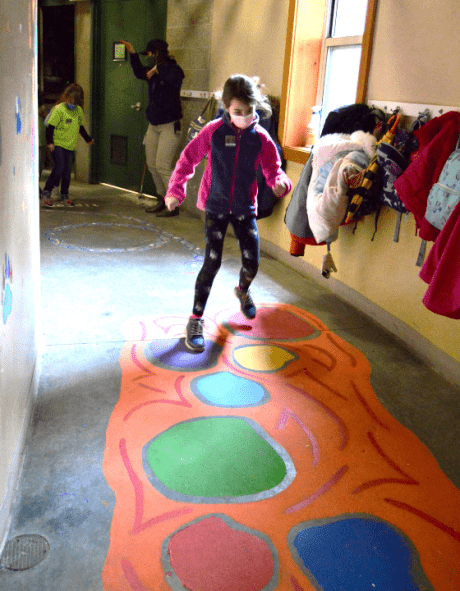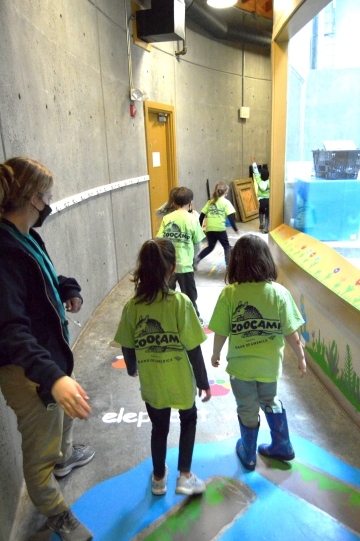
“When you try to keep in mind that inclusive design benefits everyone, suddenly the scope of impact balloons.”
ZooCamp at Roger Williams Park Zoo in Providence has an additional tool to help support campers with autism spectrum disorders or who need a sensory break, thanks in part to funding from the Paul V. Sherlock Center on Disabilities.
In 2019, the Sherlock Center awarded the zoo an Access for All Abilities Mini Grant to install a sensory pathway in its Education Center, which serves campers ages 6 to 11. It includes a variety of physical challenges, stepping courses, counting games, balance challenges and more painted on the floor and walls.
DJ Hill, manager of family programs at the zoo, said the pathway gives campers a safe and fun place to be active, learn or relax. They use it when they arrive in the morning, when they’re moving between activities and as a quiet place to calm down after feeling overwhelmed.
“The zoo setting offers unique opportunities for hands-on, sensory-rich learning experiences allowing campers to explore and understand the natural world, and our nature-themed pathway is reflective of our identity,” he said. “We leaned on what we already knew worked for campers in the past when de-escalating and refocusing – things like full body movement, obstacles and counting.”

He said they also see the pathway sparking conversation, challenge and play among campers, which also helps support their social skill development.
Hill said the pathway is not only an additional tool for staff but has been “a source of joy.”
The pathway has calming and sensory-regulating elements that help campers with autism spectrum disorders (ASD) manage their sensory input. Hill said sensory activities can improve campers’ focus and attention, making the learning experience better for all, and encourage social interaction to help campers make friends.
“Sensory pathways can help reduce stress and anxiety levels, providing therapeutic benefits for campers with ASD,” he said. “We believe that the experience of all campers AND staff is enhanced by the impacts that our sensory pathway has provided.”
To ensure the pathway is accessible to campers of all abilities, they made sure the wall elements are at different heights so everyone can reach them. In addition to the elements that focus on movement, the components also can be used visually so everyone can enjoy the pathway.
The zoo’s overnight programs also have used the pathway, and Hill said it influenced the design of the zoo’s new education building voters approved funding for in last year’s election.
Hill said sometimes when educators and caregivers take an idea like this to “the powers that be,” it can be hard to articulate the value of investing money, time and energy into these projects
“For us, how do we justify closing a portion of the building, disrupting the work of education, event and janitorial staff while we paint logs, flowers and rocks on the floors and walls?” he said. “We spoke to the value that the additions would provide to our campers with ASD, but the reality is that the benefits stretch beyond that. When you try to keep in mind that inclusive design benefits everyone, suddenly the scope of impact balloons. The Sherlock Center mini grant program has provided us with the opportunity to pilot this tool and gave us lessons to lean on when we eventually build a new building and with it, a new sensory pathway.”
